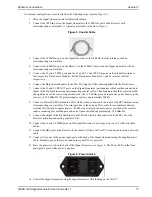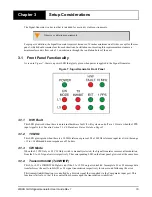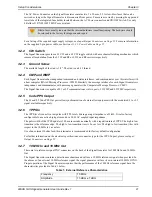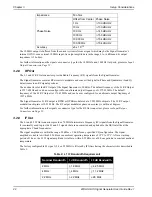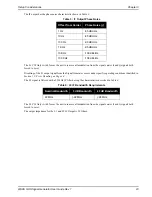
24
WAAS GUS Signal Generator User Guide Rev 1
Chapter 4
Operation
Before operating the Signal Generator for the first time, ensure that you have followed the installation instructions
of
Chapter 2, Minimum Connections on Page 15
and
Chapter 3, Setup Considerations on Page 19.
The following
instructions are based on a configuration such as that shown in
“Signal Generator Setup Example” on page 16
. It is
assumed that a personal computer is used during the initial operation and testing for greater ease and versatility.
4.1
Communications with the Signal Generator
Communication with the Signal Generator is straightforward, and consists of issuing commands through the WMP
communication ports from an external serial communications device. This could be either a terminal or a PC that is
directly connected to the Signal Generator serial port using an extension cable. For information about commands
and logs that are useful for basic operation of the Signal Generator, please see
4.1.1
Serial Port Default Settings
The Signal Generator communicates with your PC or terminal via the communication ports. For communication to
occur, both the Signal Generator and the operator interface have to be configured properly. The Signal Generator
data ports’ settings are as follows:
• 19200 bps, odd parity, 8 data bits, 1 stop bit, cts/rts handshaking, echo off
4.1.2
Communicating Using a Remote Terminal
One method of communicating with the Signal Generator is through a remote terminal. The Signal Generator
allows proper RS232 interface with your data terminal. To communicate with the terminal, the Signal Generator
requires the RX, TX, RTS, CTS and GND lines to be used. Ensure that the terminal’s communications set-up
matches the Signal Generator’s RS232 protocol.
4.1.3
Communicating Using a Personal Computer
A PC can be set up to emulate a remote terminal as well as provide the added flexibility of creating multiple-
command batch files and data logging storage files. Any standard communications software package that emulates
a terminal can be used to establish bidirectional communications with the Signal Generator. No particular terminal
type is assured. All data is sent as raw characters.
You can create command batch files using any text editor; these can then be directed to the data port that is
connected to the Signal Generator using a communications software package. This is discussed later in this chapter.
4.2
Message Control and Data Lines
The signal generator will modulate CMP messages onto the carrier if a complete CMP message is received in the
period between 20 ms and 980 ms after the respective L1 1 PPS or L5 1 PPS pulse.
The Message Interface provides the necessary control and data lines to allow downloading of data symbols from the
CMP to the Signal Generator. These lines are:
• MSGRDY from CMP to Signal Generator
• MSGCLK from Signal Generator to CMP
• MSGDATA from CMP to Signal Generator
After a compared message is stored in the Comparator output buffer, the Comparator sets the Message Ready flag
to the Signal Generator.
Nominal GUS operation can use the reference 1 PPS to trigger the transmission of a CMP message
as the L1 1 PPS and L5 1 PPS pulses should be in advance of the external 1 PPS by about 130 ms.








